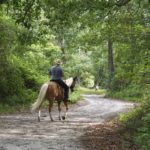Horse enthusiasts are all too familiar with stories of family farms and equestrian facilities being swallowed up by suburban sprawl, a trend which appears to be unavoidable. However, that does not have to be the case. There are tools available to help protect our precious farms and hay fields. One such tool is a Purchase of Development Rights program, also referred to as PDR or PACE programs (purchase of agricultural conservation easements).

Despite devotion to their land, many farm owners cannot afford to decline lucrative purchase offers from developers. PDR programs can help land owners continue their agricultural and equestrian ventures, and benefit from the development value of their land without having to sell.
A PDR program is a voluntary program whereby a public agency or land trust makes a monetary offer to a landowner to buy the development rights for that property. Once an agreement is made, the property is restricted, either for a specified period of time or permanently depending on the particulars of the program, from future development for residential, commercial, or industrial purposes. A legally binding agreement is made to ensure that the parcel will remain agricultural or as open (green) space. The development restriction remains with the property for the term of the agreement even if the property is rented, leased, sold, or transferred to heirs.
One example of a successful PDR program is in the Horse Capital of the World; Fayette County, Kentucky’s program was the first agricultural PDR program created by a local government in the state. With a goal of eventually purchasing development rights on 50,000 acres to protect local farmland for general agriculture, equine and tourism industries, this program currently enrolls 228 farms totaling more than 25,000 acres, of which 92 are general agriculture farms, 123 horse farms, and 13 “other” properties (sod, forested, etc). The largest farm in Fayette County’s PDR program is Waterwild Farm, owned by the Millard family of Lexington, with 530 acres devoted to horses, hay, cattle, corn, soy beans, and tobacco. “Waterwild Farm has been in my family since 1883, so finding a way to preserve this heritage was important to us,” said owner Jamie Millard. “The more we looked at the PDR potential, the more good sense it made.”
HOW IT WORKS
Landowners interested in participating in a PDR submit an application for their property or a portion thereof. Applications are typically accepted annually and are available on-line or through the planning or agriculture department. Applications are reviewed by the governing entity using a point-based scoring system to select tracts for inclusion in the program. Priority may be given to properties of a certain minimum acreage; soil quality; land which has been actively farmed; the owner?s demonstrated commitment to farming through on farm investment; adjacency to other conserved land, property which has environmentally-sensitive areas, historic or scenic qualities; or land that is located in designated focus areas or rural greenways.
When a property is chosen for participation in a PDR program, an independent certified real estate appraiser is retained by the governing body to complete an appraisal of the development rights. This value represents the difference between the development value and the value if the land is restricted
for agricultural use only. Upon completion of the appraisal, the land owner is contacted by the PDR board with an offer for purchase of the development rights. By offering a cash payment for development rights, a PDR program provides land owners the ability to preserve their land for farming and enhance their financial position. PDR funds can help farm owners meet financial needs, i.e. pay off debts, purchase equipment, make investments in buildings, and fencing; all while retaining ownership of the land. “With proceeds from PDR, we were able to make substantial improvements to the property and equipment,” explained Millard. “In the process, we added the equine division to the farm, converting a former tobacco barn into stables, and also developed a hay production program.”
Another benefit of a PDR agreement is that it can assist in passing the farm from one generation to another. Once the development rights have been separated from the land, the value of the parcel typically declines to its agricultural-only value, which can significantly reduce the inheritance tax liability. If taxed at the full development value, many parcels are simply taxed out of agriculture, because the heirs are not able to pay the taxes without selling the land.
A land owner’s decision to participate in a PDR program requires careful consideration, as this will affect the property use, one’s estate, and future owners. Planning should involve family members, financial planners and an attorney. Additionally, landowners should obtain a full understanding of the PDR program to which they apply including the things such as the application procedure, length of term of protection, restrictions on the land, renewal process if time limited, and monitoring requirements.
For more information, contact the Equine Land Conservation Resource at info@elcr.org or www.ELCR.org





